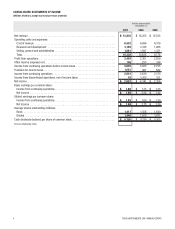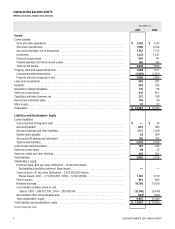Texas Instruments 2007 Annual Report Download - page 18
Download and view the complete annual report
Please find page 18 of the 2007 Texas Instruments annual report below. You can navigate through the pages in the report by either clicking on the pages listed below, or by using the keyword search tool below to find specific information within the annual report.
16 TEXAS INSTRUMENTS 2007 ANNUAL REPORT
Property, Plant and Equipment and Other Capitalized Costs: Property, plant and equipment are stated at cost and depreciated over
their estimated useful lives. Beginning in January 2006, these assets were depreciated using the straight-line method. Prior to
January 2006, these assets were depreciated primarily using the 150 percent declining-balance method (see Change in Depreciation
Method below). Leasehold improvements are amortized using the straight-line method over the shorter of the remaining lease term
or the estimated useful lives of the improvements. Acquisition-related costs are amortized on a straight-line basis over the estimated
economic life of the assets. Capitalized software licenses generally are amortized on a straight-line basis over the term of the license.
Fully depreciated or amortized assets are written off against accumulated depreciation or amortization.
Change in Depreciation Method: Effective January 1, 2006, as a result of a study made of the pattern of usage of our long-lived
depreciable assets, we adopted the straight-line method of depreciation for all property, plant and equipment. Under the provisions of
SFAS No. 154, “Accounting Changes and Error Corrections, a replacement of APB Opinion No. 20 and FASB Statement No. 3,” which
became effective as of January 1, 2006, a change in depreciation method is treated on a prospective basis as a change in estimate.
Prior period results have not been restated. We believe that the change from the 150 percent declining-balance method to the straight-
line method better reflects the pattern of consumption of the future benefits to be derived from those assets being depreciated and
provides a better matching of costs and revenues over the assets’ estimated useful lives.
Long-term Investments: Long-term investments consist of marketable equity securities, non-marketable equity securities, venture
capital funds and mutual funds. Cost or amortized cost, as appropriate, is determined on a specific identification basis.
Investments in marketable equity securities are classified as available-for-sale and are stated at fair value, which is based on
available market quotes. Adjustments to fair value of these investments are recorded as an increase or decrease, net of tax, in other
comprehensive income except where losses are considered to be other-than-temporary, in which case the losses are recorded in other
income (expense) net. Marketable equity securities are considered other-than-temporarily impaired if they have traded below their cost
basis for more than six months.
Investments in non-marketable equity securities, primarily comprised of investments in early stage development companies, are stated
at historical cost and are subject to a periodic impairment review. Any impairment considered other-than-temporary is recorded in
other income (expense) net.
Investments in venture capital funds, generally representing limited partnership interests, are accounted for under the equity method of
accounting where we have more than a 3 percent limited partnership interest and under the cost method of accounting where our limited
partnership interest is less than 3 percent. For our investments accounted for under the equity method, our proportionate share of the
net income or loss of the limited partnerships is recorded in other income (expense) net. Investments in venture capital funds are also
subject to a periodic impairment review. Any impairment considered other-than-temporary is recorded in other income (expense) net.
Investments in mutual funds are classified as trading securities and are stated at fair value. These mutual funds hold a variety of debt
and equity investments and are intended to generate returns that offset changes in certain liabilities related to deferred compensation
arrangements, thus they are classified as long-term investments. Adjustments to fair value of both the mutual funds and the related
deferred compensation liabilities are recorded in selling, general and administrative expense (see Note 10 for a discussion of Deferred
Compensation Arrangements).
Goodwill and Intangible Assets: Goodwill is not amortized but is reviewed for impairment annually or more frequently if certain
impairment indicators arise. We complete our annual goodwill impairment tests as of October 1 for our operating segments, which have
been designated as reporting units based on an analysis of economic characteristics and how we operate the business. This annual
test is performed by comparing the fair value for each reporting unit to its associated book value including goodwill. For each of the
periods presented, the fair value exceeded the carrying value, including goodwill, therefore no impairment was indicated.
Intangible assets are amortized on a straight-line basis over their estimated lives. Fully amortized intangible assets are written off
against accumulated amortization.
Changes in Accounting Standards: In September 2006, the FASB issued SFAS No. 157, “Fair Value Measurements,” which provides
guidance on how to measure assets and liabilities that use fair value. SFAS 157 will apply whenever another U.S. GAAP standard
requires or permits assets or liabilities to be measured at fair value. SFAS 157 does not expand the use of fair value to any new
























